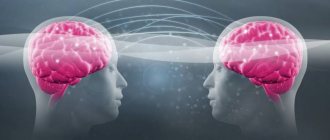The disorder is expressed in obsessive actions or movements caused by equally obsessive thoughts, pathological fears and various phobias.
According to various estimates, the number of people susceptible to the syndrome varies between 1-3%. The disease can be episodic, progressive or chronic.
OCD begins to develop between the ages of 10 and 30. Despite the fact that the initial visit to the doctor occurs 5-8 years later, on average it is about 26-36 years.
Those suffering from the disorder are very suspicious people, with unexpected and decisive manifestations against the background of prevailing equanimity. The picture of the disease is characterized by repeated melancholy obsessive mental images or desires, which are perceived as meaningless and cause the person to try to resist, however, unsuccessfully.
Typical topics of obsessions:
- aggressive or sexually promiscuous images and thoughts
- fear of pollution and infection
- moral and religious phobias
- fear of being without necessary things or losing them
- fear of hurting someone
- increased attention to something that is perceived as the cause of bad luck or good luck
- the idea of fixed symmetry and “correctness” of the entire environment
Obsessions provoke compulsions - repeated rituals designed to protect the patient from an imaginary danger, which he assesses as real.
A classic example is washing your hands after every touch. Moreover, often the patient understands the meaninglessness of his behavior, but is unable to fight it. After the ritual, he experiences short-term relief, then the cycle repeats again and again.
Hypnotherapy - diagnosis and treatment algorithm
Treatment is preceded by diagnosis, during which psychopathy and organic disorders are excluded and the prevailing emotion in the development of the disorder is established: fear, guilt, resentment or something else.
There is a misconception that hypnotherapy works almost against the wishes of the patient. In fact, and every honest specialist will confirm this, an effective complete cure is always the result of joint work between the doctor and the client.
Therefore, when seeking professional advice, you should not relax and think: “I paid, and then it’s not my concern. She’s a doctor - so let her treat!” It is necessary to tune in to composure and fruitful cooperation with the hypnologist.
Complete trust is very important when you allow a person into your subconscious to detect and correct violations. Therefore, after establishing the nature of the disorder, it is necessary, together with the doctor, to decide on the goals and treatment algorithm.
The desired result will determine the volume and specifics of the services provided. Treatment often includes 3-5 sessions (in some lucky cases, one is enough) and involves, if necessary, the involvement of other specialists.
At the same time, the person who seeks help must realize that the hypnologist will not instill in him some new superpowers, but will restore the normal functioning of his own nervous system, eliminating the underlying causes of the disorder.
The use of hypnosis for neurosis
A person does not always resort to the help of specialists when he begins to have a mental disorder. However, various pathologies develop due to nervousness, pressure surges and constant headaches are observed. It is useless to extinguish nervous tension with sedatives and treat symptoms without eradicating the main cause of neurosis. In these cases, hypnotherapy is effective because it allows you to get to the problem itself. Most often it is used for such forms of neurosis as:
- neurasthenia;
- hypochondria;
- panic attacks, fears;
- obsessive thoughts;
- increased anxiety;
- phobias.
There are several techniques for influencing the human psyche. However, to use any of them, the specialist must establish a trusting relationship with the patient. This is achieved not only in personal conversations before the start of treatment, but also during the sessions themselves: the doctor imitates the patient’s voice, his gestures and facial expressions.
At the next stage, the doctor interrupts the regularity of “communication,” confusing the patient. In this way, it is easier to put a person into a trance, he becomes more susceptible to suggestion. The style of the specialist’s phrases also changes: he speaks a lot and for a long time, inserting attitudes into sentences that the patient accepts. When a person is in a trance, the doctor begins to evoke emotional experiences from the past.
My competencies
As a hypnotherapist, I help my patients get rid of idiosyncrasies, manias, phobias, tics, panic attacks and other manifestations of diseases of a psychosomatic nature, such as:
- Causeless attacks of melancholy, horror, resentment, hatred, pity.
- Phobias associated with public speaking, judgment, strangers, sex, dating, confined spaces, talking on the phone.
- Fear of darkness, heights, speed, sounds of moving vehicles.
- Conditions of rapid heart rate, shortness of breath, nervous tics, skin rashes, depression.
- Addictions, including: overeating, alcoholism, gambling addiction, kleptomania, smoking, etc.
Does hypnosis help with neurosis?
Neurosis is a disease that can be not only corrected, but also treated. Since pathology is associated with the depths of the human subconscious, the original source of the problem is located there. Hypnosis is one of the effective ways to get to the root of a mental disorder. Many psychotherapeutic methods fail to do this in the treatment of neurasthenia, phobias and other forms of mental disorders.
During the session, the patient plunges into the depths of his memory, “finds” the place, time and cause that became the starting point of the neurosis. A subconscious encounter with a problem allows you to look at it differently, change your attitude towards it, and find resources to solve it. The patient does not need to learn to control his emotional state. When the source of the problem is “extracted” from the head, the emotional state itself will return to normal.
The advantages of hypnotic influence also include the absence of side effects, as with taking medications, psychological comfort, and quick results. Disadvantages include the immunity of some people to hypnotherapy, as well as the return of symptoms of the disorder if the patient has not done enough work on himself after the sessions.
Meditation as the key to self-hypnosis
Meditation is the process of relaxing the body and focusing attention on one's own breathing, bodily sensations, or a foreign object. As a result, the mind is cleansed of negative thoughts, unnecessary experiences, and irritants from the outside world.
Using meditative techniques, a person is able to enter a trance-like hypnotic state and, through self-suggestion, achieve a state of serenity and harmony for sleep and calming the nervous system.
Instilling certain attitudes into yourself will allow you to change your habits, way of thinking and behavior. Thereby having a positive impact on well-being and self-realization in general.
How neuroses manifest themselves: symptoms of neurotic disorders
Since among the causes of the development of neuroses, psychogenic factors play a dominant role, the majority of manifestations of disorders are due to psychotic, psychological and behavioral symptoms.
With neurotic disorders, a person is characterized by excessive timidity and indecisiveness. Difficulties in social interaction are often present in his life. Due to inadequate self-esteem, it is difficult for him to establish strong connections in society and improve his personal life. Common signs are distrust, impressionability, timidity, vulnerability, vulnerability. Often a person becomes tearful for no reason.
Accompanying neurotic disorders are unreasonable uncontrollable fears, illogical uncontrollable anxiety, anticipation of an inevitable tragedy, which often manifest themselves in attacks of panic attacks. With a neurotic disorder, others notice the patient’s excessive irritability and violent reaction to stressful situations. Even to minor stress factors, an individual experiences affective reactions: in some individuals there is deep despair, and in others there is pronounced aggressiveness and conflict.
A feature of neuroses is the patient’s fixation of attention on traumatic circumstances. This fixation on problems creates an environment in which a person is unable to work fully and cannot cope with his routine responsibilities, and gets tired of his usual activities abnormally quickly. The cognitive abilities of the individual also suffer, and memory deteriorates.
A frequently present symptom of neurosis is mood lability : in a sick person, joy and fun quickly replace melancholy and sadness. In the disorder, there is a high sensitivity to foreign irritating agents: the subject reacts violently to loud and sharp sounds, bright lighting, and changes in temperature.
Almost always, with a neurotic disorder, problems arise with the quality and duration of sleep. Due to excessive stimulation of the nervous system, he cannot fall asleep for a long time in the evening hours. Having fallen asleep, the subject often wakes up in the middle of the night, so in the morning he feels weak and lacks energy. Eating disorders are recorded: lack of appetite or insatiable hunger, a feeling of malnutrition or very rapid satiety. With neuroses, a hypochondriacal mood may arise - excessive concern for one's own health.
The above symptoms are accompanied by somatic and vegetative symptoms, which are not a consequence of the presence of any physical pathology. Among them are:
- various psychalgia - development of pain in the heart area, headache, aching sensations in the joints, gastrointestinal colic;
- dizziness, feeling of impending fainting;
- increased sweating;
- changes in heart rate;
- blood pressure surges;
- frequent urge to urinate;
- lack of attraction to the opposite sex, deterioration of potency;
- dyspeptic disorders.
Why do neurotic disorders occur: causes of neuroses
Nowadays, the influence of biological factors in the development of a neurotic disorder is minimized. A functional malfunction in the functioning of organs or systems, a lack of production of certain neurotransmitters, or a malfunction in neurotransmitter metabolism are only the basis for the formation of neurotic reactions, making a person more vulnerable to negative influences. However, somatic defects in themselves do not cause the development of neuroses.
Scientists name psychogenic factors as the fundamental reasons provoking the formation of neurotic disorders. The foundation for the development of a neurotic disorder is:
- psychological characteristics of the individual, specific characterological traits;
- unfavorable conditions for growing up and raising a person;
- problems in the formation of social relationships;
- inadequate self-esteem;
- lack of understanding of one’s place in life, lack of a clear value system.
Neurotic disorders arise due to the fact that the subject experiences acute intense emotions or prolonged negative experiences during external or internal conflicts, under the influence of traumatic circumstances, during stressful situations. A common cause is prolonged mental or emotional stress. Neurotic level disorders can develop when the subject is unable to satisfy his basic needs.
Neurosis can arise if a person is in a situation that poses a real threat to his life and well-being, which he tries to correct, but is not able to change. Very often, neurotic disorders are formed when a person lacks knowledge and skills on how to cope with unpleasant phenomena in adequate ways. For example, when, due to circumstances, he is in a humiliated position and suffers a dismissive, aggressive or overly controlling attitude towards him. Against this background, a person experiences strong affective reactions. Without knowing how to constructively neutralize one’s destructive emotions, a person over time acquires even more problems in the form of negative feelings and painful conditions. The psyche, having exhausted the existing reserves for “extinguishing” negative experiences, “rewards” the subject with neurotic reactions.
What is neurosis and what are its manifestations?
Before we talk about the features of treating neurosis, let's look at what it is. So, neurosis is a reversible borderline mental disorder that is caused by life traumatic factors, as well as conscious of the client
and occurring directly without disrupting the perception of the real world.
Some, unfortunately, do not attach much importance to such disorders and simply believe that neurotic conditions will go away on their own. But it is not so. The sooner we address the problem, the better for each of us.
Music therapy for sleep
By using soothing sounds and music, a slight hypnotic state can be achieved. The sounds of nature or birds help to distract your attention from the constant thoughts spinning in your head. Your mind calms down and you fall asleep. Musical hypnosis for sleep and relaxation helps relieve stress. You can listen to soothing sounds both in the evening and just before bed. The pleasant noise will gradually distract you from your thoughts, and you will easily fall asleep.
There are specially recorded hypnosis techniques for sleep. They prepare the body to fall asleep. By listening to the words and doing the actions of the hypnologist, you are distracted. You establish a connection with your body and calm your mind. Videos and audios like these are meditative hypnosis for deep sleep.
Phobias and hypnosis
Phobic anxiety disorders also belong to neurotic conditions. A phobia manifests itself in a panicky, irrational, obsessive, uncontrollable fear of a certain situation. A phobic situation, even when expected, causes premature fear. The most common are fear of open space (agoraphobia), fear of natural disasters, fears for one’s own health, phobias towards animals, aerophobia and others.
An attack of phobia is, according to experts, an effect of the subconscious on the body and brain. This is an unconscious reaction caused by a place, situation, object, phenomenon. It is often impossible to control. This reaction is accompanied by painful experiences. Phobic disorders are caused by traumatic situations experienced in the past. Such a violation causes a lot of inconvenience to a person and reduces the quality of life.
Hypnosis is an effective method for getting rid of phobias. Moreover, it is better to start treatment while the formed fear has not yet turned into a phobia. During a hypnotic trance, the hypnotherapist instructs the patient not to panic and transforms his attitude towards the traumatic situation. During the session, a situation can be simulated in which the patient is faced with an object of fear. Gradually, the patient’s attitude to the frightening situation and its perception change, and the internal conflict is overcome. As a result, fear disappears.
You can learn in detail about the treatment of fears and phobias with hypnosis on this You-tube channel.
Treatment (OCD) with hypnosis reviews
Currently, hypnosis is widespread. People turn to hypnologists for a variety of reasons. The most common situations for the use of hypnosis are various phobias, fears, depression, digestive, sexual disorders, weight correction, obsessive-compulsive disorder (OCD). Moreover, in cases of treatment of phobias, fears, depression, panic attacks, irritable bowel syndrome (IBS), obsessive-compulsive disorder (OCD), hypnotherapy remains the only effective method, since it is aimed at ridding the patient of the causes of his illness, while like all other methods, including pharmaceuticals, they only claim to relieve symptoms. Obsessive-compulsive disorder is a psychogenic disease, which means it can be treated, which is aimed at eliminating the cause of the occurrence and development of the disorder - an intrapersonal (usually unconscious) conflict in a person and contradictory experiences.
OBSESSIVE-COMPULSIVE DISORDER (OCD)
Obsessive-compulsive disorder (OCD) is a mental disorder characterized primarily by the presence of obsessions (uncontrollable, intrusive thoughts) and compulsions (stereotypical, compulsive behavior aimed at reducing the anxiety caused by the obsessions).
Most often, obsessive-compulsive disorders appear after stress and the disease is called obsessive-compulsive disorder - OCD (the old name is obsessive-compulsive disorder). With OCD, the patient is concerned about:
* intrusive (obsessive) thoughts, images, memories, desires;
* repeated stereotypical behaviors (repetitive (compulsive) actions or rituals) in order to eliminate anxiety and internal discomfort;
* obsessive religious or moral ideas;
* fears of various contents;
* desire for order and symmetry: the idea that everything should be lined up “correctly”;
* superstitions, excessive attention to something that is considered as good or bad luck;
* anxiety, restlessness.
The origins of obsessive-compulsive neurosis lie in early childhood, in the particular development and upbringing of the child; the first complaints may appear in adolescence, however, they are not always given due attention. The basis of this neurosis is the so-called psychasthenic intrapersonal (unconscious) conflict, which is closely related to the characteristics of upbringing in early childhood. Its essence lies in the contradiction between the child’s aspirations (instinctive drives) and morality, ethics, duty (in the form of educational guidelines, requirements, rules of behavior). Initially, being an external contradiction, over time, this conflict becomes intrapersonal, that is, such a person constantly tries to fight with himself, which causes constant tension, doubts, and self-doubt, which manifests itself in obsessive symptoms.
The difficulty of the situation for patients with this disease is often associated with a complete lack of understanding of their condition by their family and friends. The complexity of the patient’s situation can be understood either by a person who has experienced something similar or by a psychotherapist - a hypnologist who has many years of experience working with such patients. It is impossible to eliminate the problem of OCD with rational arguments, since their source lies in the sphere of the unconscious, which is the basis for treating this illness with the help of hypnosis.
Professional influence using proprietary methods is one of the most effective services at present. Our proprietary technique “OCD no more!” allows you to identify and eliminate the cause of the disease, and completely rid the patient of this illness in just three to five sessions.
During the conversation, it was sometimes possible to find out what triggered the OCD and in subsequent hypnosis sessions to remove their obsession and relevance. In cases where the patient could not remember the source of the disease, the task became more complicated, since it was necessary to carry out hypnotic regression of the entire age, hypnoanalysis and find the onset of the disease, sometimes even at a very early age. Those who suffer from OCD should not be disappointed and lose hope for healing, since with our help you will forever rid yourself of this illness in just three to five sessions.
Why does this disorder occur?
Each case is unique; there is no clear answer to this question. Typically this is:
- an isolated case of severe shock associated with the patient himself or with people close to him;
— internal struggle between necessity and acceptance of responsibility;
- long-term psychotraumatic situation associated with conflictual relationships in the family, living conditions, difficulties at work, etc.;
- being in a place where a traumatic event previously occurred;
- in the features of child development and upbringing.
In the treatment of obsessive disorders, different methods are used depending on the nature of the disease.
Currently, we have developed our own method “OCD no more!” to overcome obsessive syndrome in just three to five sessions.
Description of the method.
- * 1.Search for the causes of ORC using regressive hypnosis. It is known that the underlying cause may be related to psychological trauma. Often the problem is old, coming from childhood. Eliminating this found psychological trauma will allow you to get rid of this illness forever.
- * 2. Search using regressive hypnosis for the causes that gave rise to psychological trauma. Eliminating this found cause will avoid a repeat painful reaction in the future.
- * 3. Application of cognitive-behavioral techniques and techniques.
- * 4. Elaboration of intrapersonal conflict leading to the appearance of symptoms.
- * 5. Formation of a stable neutral or positive reflex to an object or situation that causes OCD.
- * 6. Construction of a new healthy association in the unconscious to form a stable, healthy reaction to similar events in the future.
- * 7. Using the hypnotic progression method: consolidating new healthy dominants, stable neutral or positive associations for the rest of your life.
- * 8. Therapeutic restorative hypnotherapy - relaxation.
Are there possible side effects from hypnosis?
According to experts, to date no such cases have been identified. Research at different times was carried out by such prominent and authoritative scientists as: V.M. Bekhterev, I.P. Pavlov, S.S. Liebig (1974), A.I. Zakharov (1982), A.A. Tokarsky (1989), M.S. Lebedinsky, A.T. Pshonik (1952), L.L. Vasiliev, I.P. Bryazgunov (1970) L. Chertok (1972), V.I. Sukhorukova (1977), P.K. Anokhin, S.L. Rubinstein, V.Ya. Danilevsky, A.M. Svyadosch (1982), K.I. Platonov, A.P. Slobodyanik, V.E. Rozhnov, A.A. Ukhtomsky, I.M. Sechenov, etc.
Positive aspects of hypnotic treatment for OCD:
· — Complete absence of drug effects on the human body.
· — Has a healing, restorative effect on all human organs and systems.
· — No side effects.
· — Complete 100% relief from obsessive-compulsive disorder (OCD) for life.
· — Elimination of the causes of the disease in just three to five sessions.
· - Cheaper.
A hypnosis session for the treatment of OCD in itself is healing for a person. Hypnosis improves a person’s overall well-being, ensures the coordinated functioning of all organs and systems of the body, which allows the patient to feel a new surge of vitality. It has a positive effect on the functioning of many organs and systems: cardiovascular, respiratory, endocrine, digestive, central nervous system, helps with insomnia, relieves irritability, reduces anxiety, soothes headaches, etc.
Independent attempts to get rid of OCD leads to the consolidation of new fears and fears with further depression of the central nervous system, an inferiority complex, and false beliefs that it is impossible to get rid of this illness. It is impossible to eliminate the problem of OCD with conscious arguments, since their source lies in the sphere of the unconscious, which is the basis for treating this syndrome with the help of hypnosis. And only hypnotherapy helps overcome the negative consequences for your nervous system.
Morbidity statistics
As a rule, people suffering from obsessive-compulsive disorder (OCD) turn to hypnologists and psychotherapists already having an impressive layer of symptoms and rituals that seriously limit their capabilities and reduce their quality of life. The prevalence of OCD is approximately 1 – 3:100 in adults and 1:200 – 500 in children and adolescents, although clinically recognized cases are less common (0.05 – 1%).
Our proprietary method “OCD no more!” will allow you to return to normal life and enjoy it. Be healthy and take care of yourself!









